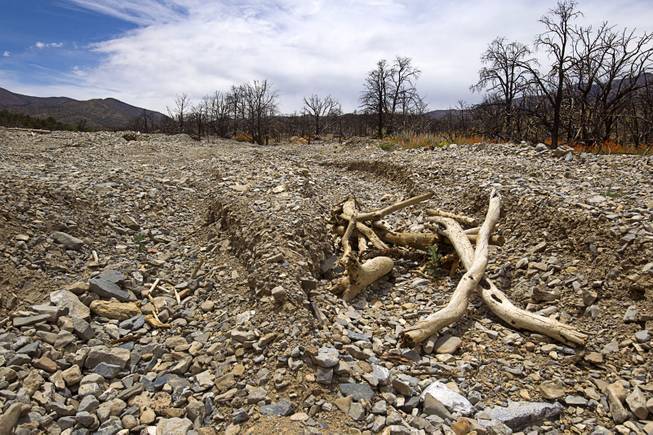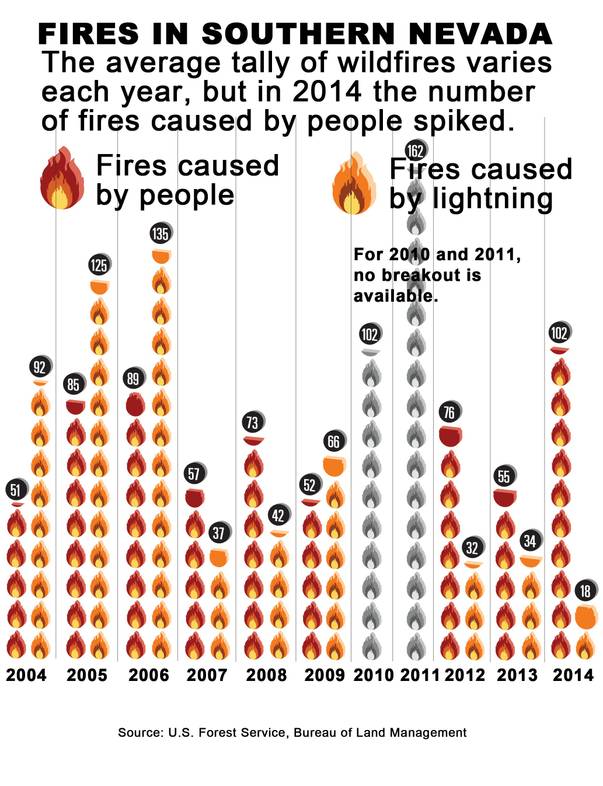
The Carpenter 1 wildland fire was one of the largest fires ever in the valley. Sparked by lightning, it began July 1, 2013, near Pahrump, burned more than seven weeks and destroyed about 28,000 acres of land. The area still is recovering today.
Monday, June 22, 2015 | 2 a.m.
As the valley gets hotter and drier, the prime season for wildfires is quickly approaching.
A lightning bolt or flicked cigarette can start a fire within seconds, potentially causing millions of dollars in damage and risking lives.
In the midst of summer vacations and weekend camping trips, here is what you need to know about how wildfires start, where they happen and how to prevent them.
How wildfires start
In general, the most common natural cause of fires is lightning, which is a problem mostly during monsoon season. But humans are another major cause.
Common causes of wildfires
■ Campfires
■ Burning trash or debris
■ Careless smoking
■ Children playing with matches or lighters
■ ATVs. Grass, weeds or brush can come in contact with the exhaust and ignite.
■ Fireworks. Even legal fireworks never are allowed in campgrounds.
■ Target shooting. Shooters often congregate on hillsides with grassy areas. If a bullet hits a rock, it can cause a spark, which can lead to a fire.
Restrictions
Southern Nevada has been under fire restrictions since May 15 to limit the risk of wildfires. The restrictions prohibit:
■ Building a campfire or using a charcoal stove. Portable stoves that use gas, jellied petroleum or pressurized liquid fuel are allowed.
■ Welding or operating an acetylene torch with open flames, except with a permit.
■ Using an explosive without a permit.
■ Using fireworks or firing bullets with flame tracers.
■ Operating an off-road vehicle without a spark arrestor.
Have a safe campfire
When restrictions are lifted, keep these tips in mind:
■ Before you start a campfire, check the weather; windy days can cause wildfires. Find a level spot away from overhanging branches, dry grass, logs, pine needles and wood. Also stay away from hillsides.
■ Never leave your campfire unattended, not even for a few minutes.
■ When you are done with the fire, drown it for 30 minutes. Fill a bucket with water and pour it on the campfire while stirring and wetting the ashes. Repeat until the fire is out completely. Don’t bury the fire with dirt; it can smolder for hours, then escape.
How to minimize the risk of wildfires
■ Avoid dry grass.
■ Watch for sparks while operating equipment.
■ Don’t burn trash or throw trash into a fire ring, used to prevent campfires from spreading.
■ Don’t leave logs hanging away from the center of a fire.
■ Don’t ignite a fire beneath overhanging limbs or brush.
■ Dispose carefully of cigarettes.
Wildfires are an essential feature of ecosystems that can regenerate plants to provide better food for wildlife and cycle nutrients through soil. But wildfires generally don’t benefit the Mojave Desert. It takes an average of 40 years to recover vegetation lost in a fire and even longer to recover animal species.
The dangers of wildfires
■ Erosion, which can lead to flooding
■ Death or injury to wildlife, including endangered species
■ Injury or death to humans and animals
■ Damage to homes, businesses and infrastructure
■ Interference with recreation and tourism
Have questions?
For more information about wildfires or restrictions, call the local branches of the following agencies:
U.S. Forest Service
702-515-5400
U.S. Fish and Wildlife Service
702-515-5450
National Park Service
702-293-8990
Bureau of Land Management
702-515-5000
Nevada Division of Forestry
702-486-5123


Join the Discussion:
Check this out for a full explanation of our conversion to the LiveFyre commenting system and instructions on how to sign up for an account.
Full comments policy